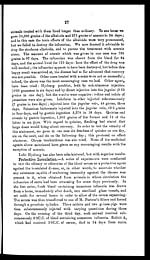Medicine - Veterinary > Civil Veterinary Departments > Civil Veterinary Department ledger series I-VI > Volume IV - Horse surra
(444) Page 28
Download files
Individual page:
Thumbnail gallery: Grid view | List view

28
B received 6.0C.C., died in 22 days. C received 9.0C.C., survived
40 days. Guinea-pigs: X received 6.00C.C., lived 34 days Y
received 6.00C.C., lived 66 days.
In the second series of experiments, blood was withdrawn from a
horse immediately after death, in which the infusorian had been
swarming for some days, and immediately subjected to the method
described by Ogata. Three guinea-pigs were subjected to daily
injection with the fluid so obtained, in varying quantities.
No. 1 received 5.5C.C., and afterwards was inoculated with virulent
blood. The animal succumbed in 66 days. No. 2 received 8 5C.C.,
and died in 19 days. No. 3 received 11.0C.C., and died in 25 days.
It is evident that there is little to be hoped for in this direction.
Measures to be adopted to prevent introduction and spread.—
In recommending measures to be adopted with a view to avoiding the
introduction of the disease, we are met with the difficulty of deciding
what the source is from which the infusorian is introduced. We have
some evidence to show that stagnant water, and sedgy vegetation
from ground liable to inundation, are to he suspected, and we should
prevent animals from gaining access to these for some time previous
to the dangerous season of the year. Looking to our observations as to
the period of incubation, in cases where the disease has been induced by
the ingestion of water containing small quantities of soiled blood
it would appear to be necessary to allow for an incubative period of at
least two months, which would bring us to the commencement of the
rains. In this regard may be quoted the fact stated by Major Money,
4th Punjab Cavalry. This officer has stated that "the disease was com-
mon amongst the horses of the 3rd Punjab Cavalry, when they obtained
the grass from inundated ground near the River Indus, but it ceased
when they got grass from higher ground."
Veterinary Lieutenant-Colonel W. A. Russell informs me that he
was successful in preventing the disease by avoiding grass from sus-
pected localities in Meerut, and that since this has been done, no cases
have occurred there.
Salt.—It would be advisable, in addition to interdicting the use of
grass and water from suspected localities, to allow each horse an ounce of
salt well mixed with the food and water daily as a prophylactic.
Arsenic.—It has been suggested that by giving arsenic as a pro-
phylactic, we might have some chance of preventing the disease. Expe-
riments are necessary to prove what efficacy this drug would have in
this direction.
Set display mode to: Large image | Zoom image | Transcription
Images and transcriptions on this page, including medium image downloads, may be used under the Creative Commons Attribution 4.0 International Licence unless otherwise stated. ![]()
| India Papers > Medicine - Veterinary > Civil Veterinary Departments > Civil Veterinary Department ledger series I-VI > Horse surra > (444) Page 28 |
|---|
| Permanent URL | https://digital.nls.uk/75517222 |
|---|




